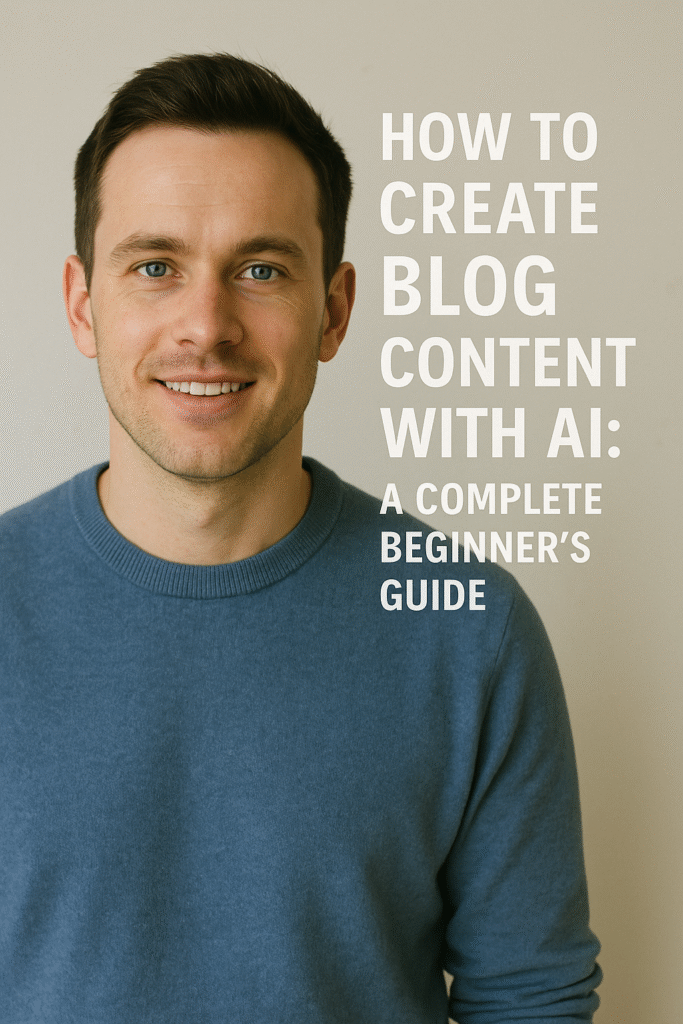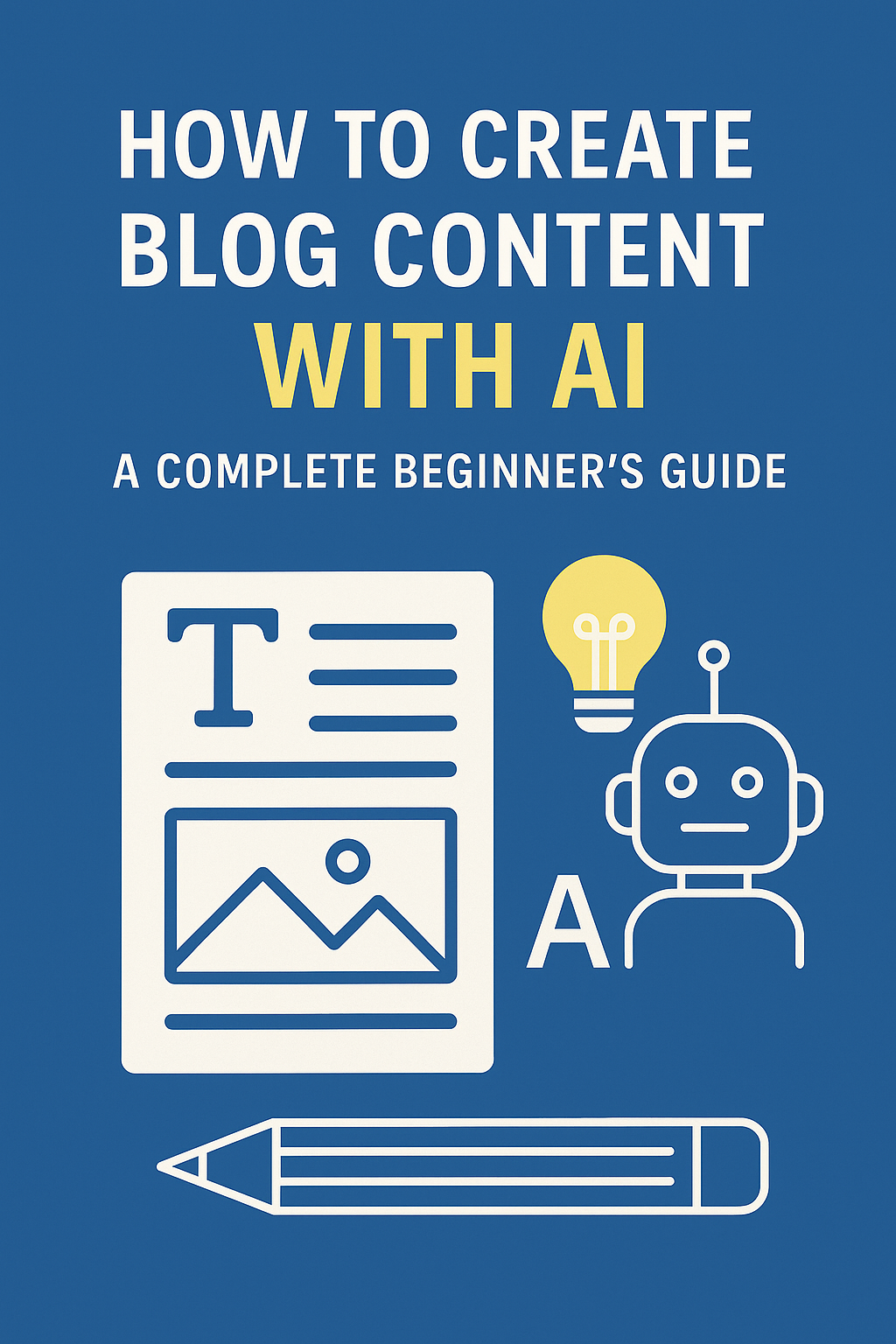Creating blog content can feel time-consuming, especially when you’re aiming for quality and consistency. That’s where AI comes in. In this guide, you’ll learn how to create blog content with AI—quickly, efficiently, and with a tone that feels 100% human. Whether you’re a beginner or a seasoned writer, AI tools can transform your blogging process.
Artificial Intelligence has transformed the content creation landscape. It helps bloggers brainstorm ideas, draft outlines, generate full-length articles, and even optimize for SEO. But many people wonder: “Can AI really write like a human?” The answer is yes—if you know how to use it the right way. In this detailed guide, we’ll explore how to use AI tools to create engaging, natural-sounding blog content. Whether you’re a complete beginner or looking to boost productivity, this guide is for you. So, let’s dive into how AI can become your best writing partner Create Blog Content with AI.
Why Should You Use AI for Blogging Content Creation?
There are several strong reasons to use AI when creating blog content. First and foremost, AI can save you a tremendous amount of time. Instead of spending hours brainstorming and writing, AI tools can help you produce an entire draft within minutes. This gives you more freedom to focus on editing and adding your personal touch. Secondly, AI helps overcome writer’s block. When you feel stuck or uninspired, AI can suggest creative directions, opening new pathways you hadn’t thought of.
Additionally, AI supports content consistency. To build a successful blog, regular posting is key. AI enables you to keep a consistent publishing schedule, even on days when you’re low on energy. Moreover, AI tools like Jasper or ChatGPT also support SEO optimization by suggesting keywords, structuring content properly, and improving readability. Finally, if you’re not a native English speaker or lack writing confidence, AI can help polish your grammar and tone. It’s like having a writing assistant by your side 24/7. Therefore, this blend of efficiency and creativity is why so many bloggers are turning to AI today.
Best AI Tools to Write Blog Content Efficiently
There are many AI writing tools available, but a few stand out for their reliability, ease of use, and effectiveness. Let’s explore the most trusted options:
1. ChatGPT by OpenAI for Blog Writing
This tool is flexible and beginner-friendly. You can ask it to generate blog ideas, outlines, introductions, and even full posts. It responds quickly and allows for follow-up prompts, so you can refine the content as you go. ChatGPT is especially great for brainstorming and conversational-style writing.
2. Jasper AI for Long-Form Blog Content
Designed for marketing and blogging, Jasper comes with templates and advanced options to fine-tune tone, audience, and intent. It’s especially useful for long-form content where structure matters. Jasper’s Boss Mode makes it easier to control the narrative flow.
3. Copy.ai for Creative Blogging
Great for writing short, persuasive text like headings, product descriptions, or intros. It’s ideal if you’re working on promotional blog content. Copy.ai is fast and focused on creativity.
4. Writesonic for SEO Blog Content Optimization
This tool excels in SEO. It helps you find the right keywords and automatically generates meta descriptions, blog ideas, and outlines with search optimization in mind. It also supports ad copy and landing pages.
5. Notion AI for Organizing Blog Ideas with AI
If you use Notion to manage your content calendar, their AI assistant can help with idea generation, drafting, and organizing—all within the same workspace. It’s handy for users who prefer everything in one place.
Each tool has free trials or freemium models, so you can test which one works best for your needs before committing. Explore them, experiment, and decide based on your specific blogging goals.
How to Write a Blog Post with AI Tools (Step-by-Step Guide)
Using AI to write blogs is not just about clicking a button. To get high-quality results, you need a clear process. Let’s break it down into steps:
Step 1: Choose a Relevant Blog Topic with AI Help
Start with a topic your target audience is genuinely interested in. You can use AI to generate topic ideas. For example, ask ChatGPT: “Give me 10 blog topics for beginner fitness enthusiasts.” This helps avoid the dreaded blank page syndrome and keeps your content aligned with what people are searching for. Additionally, try using keyword research tools like Google Trends or Ubersuggest to validate your topic choices before writing.
Step 2: Generate an AI Blog Outline for Structure
An outline provides structure and ensures your content flows logically. Ask your AI tool to create a blog outline for your chosen topic. You’ll get a breakdown like: Introduction, Problem Explanation, Solution, Tips, Conclusion. This helps you stay organized and speeds up the writing process. With a solid outline, each paragraph has a clear purpose.
Step 3: Expand Each Section with AI Writing Tools
Instead of writing everything at once, work section by section. Give the AI specific instructions like, “Write 150 words about the benefits of using AI for content writing.” You can then edit the response for clarity, personality, and flow. Additionally, make sure to keep your audience in mind—are they beginners or experts? Tailor the tone accordingly Create Blog Content with AI.
Step 4: Add Human Voice and Real Examples
AI-generated text often lacks personality. To fix that, include personal stories, real-world examples, or questions like, “Have you ever struggled to come up with content ideas?” This creates a connection with your readers. Readers want to relate to you—they appreciate authenticity and real-life experiences that help them trust your insights.
Step 5: Review, Edit, and Improve AI Blog Content
Even the best AI isn’t perfect. Read your blog aloud, correct grammar, adjust sentence structure, and replace overused phrases. Use transition words to improve flow. AI does the bulk of the work, but editing makes it feel human. It’s also a good time to check tone—make sure it’s friendly, informative, and suitable for your audience Create Blog Content with AI.
Step 6: Optimize AI Blog for SEO with AI Tools
Ask AI to include your focus keyword naturally throughout the blog. You can also generate meta descriptions, SEO-friendly titles, and heading suggestions. Furthermore, don’t forget to add internal and external links, alt text for images, and proper tags. This boosts your visibility in search engines and improves user experience Create Blog Content with AI.
Tips to Make AI Blog Posts Sound More Human and Engaging
Even though AI writes the words, it’s your job to make the content relatable and enjoyable. Here are some ways to humanize your AI-written blog:
Use Transition Words in AI Blog Content for Flow
These guide readers smoothly from one idea to the next. Examples include “however,” “in addition,” “on the other hand,” and “for instance.” Using them regularly helps maintain flow.
Vary Sentence Length in AI Writing for Better Rhythm
Mix short, punchy sentences with longer, more detailed ones. This keeps the rhythm interesting and prevents your writing from sounding flat.
Ask Questions to Engage Blog Readers More Effectively
Posing questions like “What if you could finish a blog post in half the time?” engages your audience and invites them to think. It builds interaction and breaks the monotony.
Show Your Personality in Blog Posts Created with AI
Use humor, express excitement, or share personal insights. That’s what makes content memorable. A robotic tone turns readers away; your personality brings them back.
Avoid Repetition in AI Content to Keep It Fresh
Sometimes AI repeats phrases. Scan your draft for duplicate ideas and replace them with fresh wording. Use synonyms, rephrase sentences, and add depth to ideas instead of restating.
By applying these techniques, you ensure the final result sounds like a real person wrote it—with warmth and clarity. Readers will appreciate your effort and return for more Create Blog Content with AI.
Common Mistakes to Avoid When Writing Blogs with AI Support
While AI is incredibly useful, it’s not foolproof. Watch out for these common mistakes:
Copy-Pasting Without Editing AI Content First
AI drafts often need refinement. If you publish them as-is, they may sound robotic or awkward. Editing ensures the final version reflects your tone and standards.
Ignoring Reader Needs in AI Blogs and Content
AI won’t know your readers like you do. Make sure the content is tailored to your specific niche and goals. Think about what they want to learn or feel.
Overusing One AI Tool for All Blog Writing Tasks
Using only one AI platform may limit creativity. Experiment with multiple tools to find the best fit for each stage of writing. Diversity can lead to better results.
Skipping Fact-Checks in AI-Generated Blog Posts
AI sometimes provides inaccurate or outdated information. Always verify stats, names, and references before publishing. This helps you build trust and credibility.
Failing to Add Human Value in Blog Content Written with AI
AI gives you a starting point, but it’s your insights, experience, and analysis that provide true value to your readers. Never skip the human touch—it makes all the difference.
Avoiding these pitfalls ensures your content is not only efficient but also trustworthy and engaging. The best content blends AI efficiency with human intelligence.
Final Thoughts on Using AI to Write Blog Content That Feels Human
Creating blog content with AI is no longer a futuristic fantasy—it’s a practical, time-saving solution available right now. With the right tools and techniques, you can write faster, stay consistent, and produce posts that resonate with your readers. But remember, AI is just the assistant. You’re still the author.
By combining the speed and efficiency of AI with your personal voice and knowledge, you can create blogs that are both effective and human. So why wait? Start experimenting today, and discover how AI can elevate your blogging game to the next level. Whether you’re aiming for casual lifestyle posts or professional thought leadership, AI is here to support—not replace—your creativity.
Happy writing!









